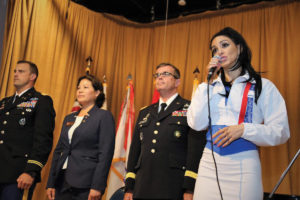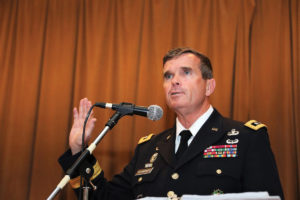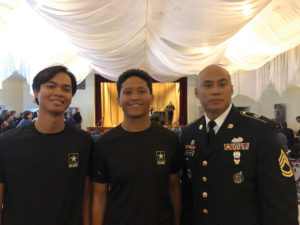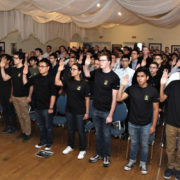NEARLY 90 young men and women joined the U.S. Army on Thursday, August 16 during a mass swearing-in ceremony in Los Angeles.
The U.S. Army Recruiting Battalion in LA brought together 83 future soldiers, from the five areas it overseas — LA, San Gabriel, Long Beach, San Fernando Valley and the coastal cities — at the Woman’s Club of Hollywood, where they took the Oath of Enlistment.

The ritual was witnessed by the recruits’ families, Army leaders, as well as community members.
Among those who took the oath were Filipinos Jamil Dancel and Brandon Antolin, who migrated to the U.S. from the Philippines within the past year.
Both said they were set on joining the Army for educational and future opportunities.
“I joined for security and personal interest,” Antolin, who came to the U.S. in December and enlisted in May, told the Asian Journal.
Dancel said that back in the Philippines, he was part of the color guard so that was part of the reason why he decided to sign up for the Army when he moved to a new country.
“I also joined because I want to get an education in engineering,” he added.
To Filipinos who are considering to join, he said, “they should have the will and passion for it.”

Becoming a soldier
In joining the Army, enlistees go through a process that involves: taking the Armed Services Vocational Aptitude Battery which is an exam to help determine a career path, a physical examination, and undergoing a career counseling session. Then they are able to take the oath.
Nationally, about 23 percent of young people are qualified to join the Army. The branch is eyeing to welcome 76,000 citizens into the active force, 140,000 across the active guard reserve, Lieutenant General Thomas C. Seamands said.
Seamands, who is the deputy chief of staff, G-1, of the Army delivered the keynote speech and administered the oath on Thursday. Coming from an Army family himself, he has been in the service for 37 years.
“We’re 17 years into our war and yet these young men and women today are stepping up, wanting to be part of something bigger than themselves. Many of them know that signing up today, they might very well be in combat at some point in the future. But what guided them here are the recruiters…who play a key role in the success of bringing in over 100,000 soldiers in the formation stage,” he told media prior to the ceremony.

About the lasting effects of being a member of the Army, Seamands said the greatest one is coming back to the community as a “better citizen.”
“Because what they’ve done while in uniform is experience, I would tell you, the world’s premier leadership experience,” he said, listing ways the branch takes care of its soldiers once they leave the service, including job training, a credentialing program, higher education options, or how to start a business.
“The parents and family members present today are probably concerned about their sons and daughters or brothers and sisters who are taking a step in the unknown. But the fact of the matter is, the Army takes care of our own. While you’re in, we’ll take great care of you and after you leave, whenever that is, we’ll make sure you’re set up for the future,” he added. “We really want to holistically take care of the family. If the family is happy, often times, the soldier will continue to serve.”

Lt. Col Patrick M. Flood, who took charge as the recruiting battalion commander in LA last July, also addressed the new soldiers.
“Just being able to meet all the folks who are here, the parents and the children who want to commit their lives to serve this nation, a place where a lot of them were not even born, is to me, pretty impressive,” Flood told the Asian Journal following the ceremony.
In the past two years, the recruiting battalion observed the highest regular Army enlistment two-year average in LA history (about 1,000 a year) and highest combined regular Army and Army reserve enlistment average in LA history (2,165 per year), as previously reported by the Asian Journal.
“Part of the reason why I chose to serve was because of how much this country had given my family. Being able to give back that to other people and now to be able to connect with all the different diverse communities… [like] the Asian Pacific Islander community and the Latino community… and to see that they’re all sitting next to each other, there’s no difference. It doesn’t matter that someone is from Koreatown or San Gabriel, the fact that they’re talking together to me is a big deal about serving in the Army,” Flood said.
Given the demographic diversity of Southern California, the battalion has been working to ensure that new recruits reflect those backgrounds.
“I think the most successful thing we can do is have a soldier to tell their story because if a soldier goes out there and says why they joined [and] why they stayed, there’s nothing more powerful than that because it’s personal. It’s not an advertisement, it’s not a billboard, it’s actually a personal story,” Seamands told the Asian Journal about the recruiting tactic that he finds most effective. “When you meet an officer who’s in uniform and believes in what they do, that’s the best selling point to help tell the story.”
The audience also heard from Janet Chin, a civilian aide to the Secretary of the Army, who based in the Los Angeles area. Chin, who is a former soldier herself and has seen her own child go through the recruitment process, shared her advice to family members who are sending their children off.
“Find every opportunity you can to connect with the Army, attend the ceremonies that are happening in your local area, talk to your neighbors or individuals who have already served, whether it’s the Army or otherwise,” she said.
Flood said that the recruiting battalion will increase its efforts to organize town halls, have parents of new soldiers share their experiences and answer questions for prospective families.
Chin added that what she learned during her time of service continues to guide her daily life, “you learn how to be resilient, your grit, you learn that failure is just the process of success and that the Army will always be there for you regardless.”
At the ceremony, each new soldier was given two tickets to an LA Dodgers baseball game.
After the oath, the recruit reports to basic training or may enter the delayed entry program (DEP), which is a commitment to basic training in the future, generally within one year.
“At the end of the day, what we want is an Army that is capable of doing what our nation asks us to do, whether it’s fighting wildfires, whether it’s deploying people to Iraq, Afghanistan, Syria, whatever our nation needs us to do,” Seamands said.







